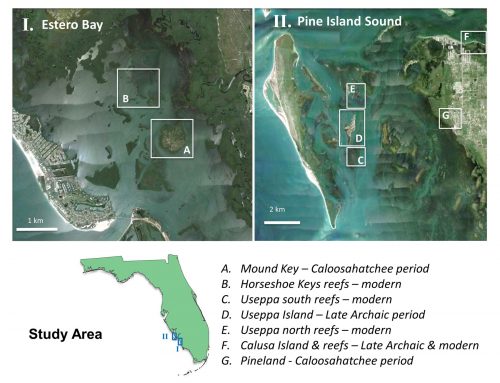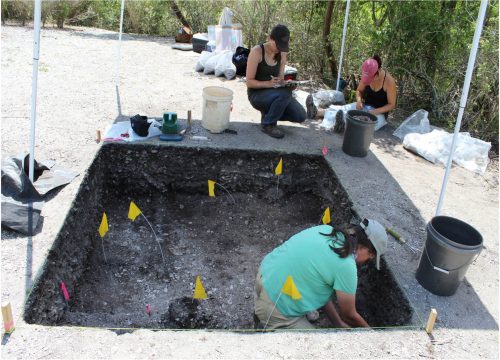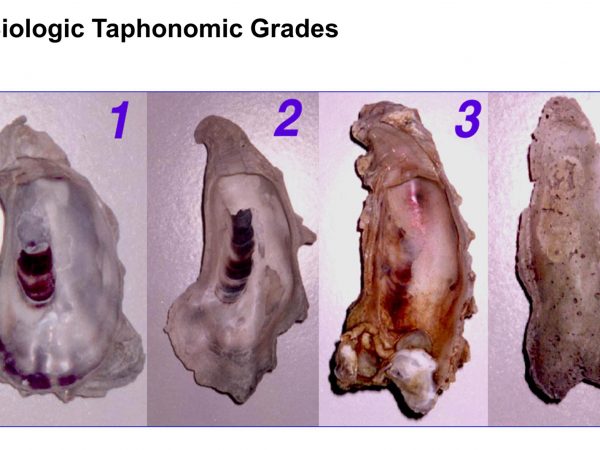The Calusa were fisher-hunter-gatherers who relied upon the bounty of estuaries to provide adequate food for a large population and to develop a culturally and politically complex society. They collected a variety of shellfish species for food, but the American oyster ( Crassostrea virginica ), perhaps because of its widespread availability and abundance, was a staple food for many centuries, up to A.D. 1550.
Many Calusa archaeological sites contain numerous oyster shells along with other mollusk shells and many fish bones. Archaeologists Karen Walker, Bill Marquardt, Victor Thompson, and I, a marine geologist, wondered whether the Calusa overharvested the oysters. Overharvesting could cause a shift to smaller sizes among individuals or, if severe enough, a permanent genetic change influencing future oyster growth or reproduction.

To investigate these questions, we sampled oyster-rich layers from middens from (1) the Late Archaic (around 2000500 B.C.) of Useppa and Calusa Islands (in Pine Island Sound), and (2) the more recent (500 B.C.-A.D. 1500) Caloosahatchee I, II, and IV cultural periods of Mound Key (Estero Bay) and Pineland (Pine Island Sound). Radiocarbon dating was used to assign each sample to a cultural period. We used taphonomic grading, a method commonly employed in paleontology, to establish whether oysters were collected alive as food, or dead for building material. Taphonomic grading is an assessment of the quality of shell preservation. Bivalve mollusks, such as oysters, if collected alive, have pristine shell interiors. If collected dead from reefs, the oyster shells would have interiors encrusted or corroded by other organisms, such as boring sponges, oyster drills, and barnacles.
Samples from all shell midden layers showed relatively clean shell interiors. Dead oyster shells collected from oyster reefs in Estero Bay and Pine Island Sound for comparison had significantly more evidence of encrustation and corrosion. This confirms that throughout their history the Indian people collected oysters for food before using the shells as moundbuilding material.
But did the Calusa affect the oyster populations? When we measured the sizes of oysters and compared them across cultural periods and localities, oyster shells from times of peak Calusa population during the later Caloosahatchee periods were significantly smaller compared to the those from the earlier periods, and shells from both samples were smaller than those of modern oyster populations that live in protected areas that are not harvested at all. This shift to a smaller mean size and subsequent return to pre-Calusa size suggests that Native Americans did overharvest enough to cause a population shift, but they did not permanently influence the oysters’ potential for growth. This pattern is not affected by climatic conditions; the size shift persists through a number of climatic warm and cool intervals.
Results from this study suggest that oysters always existed in abundance, though not to such an extent as to avoid all effects of overharvesting. Today, however, the American oyster is often commercially harvested from our Atlantic and Gulf of Mexico estuaries so intensively that oyster reef density and areal extent have been severely reduced. When coupled with other human-induced causes of estuarine health decline, such as habitat destruction, disease, and nutrient enrichment, historically productive oyster beds in places like Chesapeake Bay, New York Harbor, and Apalachicola, Florida are mere remnants of their former selves. Southwest Florida’s oyster reefs, though not commercially harvested, have declined for other reasons, and this has contributed significantly to the degradation of our coastal waters.

Overharvesting of shellfish and finfish beyond a species’ ability to sustain a healthy population size is a common societal problem that must be resolved. Overharvesting, however, is not an exclusively modern occurrence. Our work shows that Indian peoples were also capable of influencing native species through overfishing and over-hunting.

